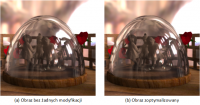The analysis and control of disparity for the realistic stereo visualisation
Prof. Przemysław Rokita and his PhD student Łukasz Dąbała from the Computer Graphics Department at the Faculty of Electronics and Information Technology, together with his colleagues from the Max Planck Institute and MIT, worked on new methods of generating high quality stereoscopic images using original method of analysis and control of the disparity. This project was carried in the years 2012-2014.
The task of generating and displaying high quality stereo images is difficult and usually involves additional manual manipulation of its content in order to reduce unwanted artifacts. Up till now, scientists have created lots of algorithms which were supposed to facilitate this process. However, they only took into account the surfaces that scatter light. Combinations of materials which possess light reflecting and refracting properties are very common in everyday life and cause quite a big problem in the context of stereo image generation. Such type of surfaces can create too high values of disparity and many stereo interpretations which can lead to overall disorientation and discomfort of the viewer.
Because of this problem, the scientists in this new project came up with the method which improves perceptual quality of the generated stereo images, giving very realistic results and in the same time reducing the probability of user discomfort.
The new method is based on images created with computer graphics. It uses the information about position of the surfaces and image decomposition into layers. After this decomposition, it is possible to assess the value of disparity for each fragment of the image. These values enable the calculation of potential regions where the rivalry between the eyes is caused by the material properties. The original optimization process is taking into account how the human visual system works. The result of the optimization gives the cameras' locations for particular pixels in the layers which enable creating a pair of stereoscopic offset images that are more comfortable for the viewer.
The results of this scientific project will be used in the film industry reducing the feeling of discomfort experienced by the viewers watching 3D movies or other stereoscopic multimedia content.
Here is a video of the Max Planck Institute website for the Eurographics 2014.







